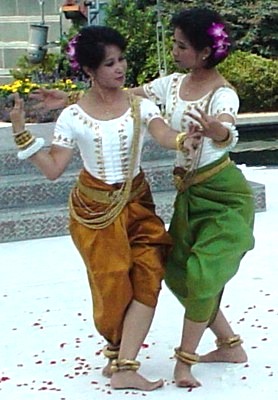|
|
Dance is a significant feature of Cambodian culture both as a social activity and as a symbol of the culture, history, and people. Cambodians trace dance styles back to before the Angkor period (9th to 14th centuries) and often speak of dance as the “soul” of the people[i]. According to a 10th century inscription, the mother of the Khmer people was Mera, who was an Apsara (celestial dancer)[ii]. Varieties of dance include social group dances, regional folk dances, and the formalized classical dance and dance-dramas, which enact mythico-historical stories.
Recreating dance and the music which accompanies it in Long Beach was a challenge.In the early days only a handful of people had the knowledge and expertise to perform and train others. An equally daunting challenge was costuming, which is an art in itself.Lacking the right materials and only a few experts to guide them, individuals recreated the dress, headdresses, and masks from memory.
|
|
Sophiline Cheam Shapiro (L) and Charya Cheam Burt (R) Los Angeles, July 25, 2004 |
The two forms of dance most often seen by the general public in Long Beach today are the classical and folk-style dances. Several groups throughout the years have formed troupes and offered classes. Today, at least two troupes perform professionally at local events. More recently the Cambodian Culture and Arts Council has worked to develop trot and chhayam troupes to perform during New Year celebrations in April.
|
|
Through photographs and video, this section provides a brief history of the creation of the various forms of Cambodian dance in Long Beach. We invite anyone who would like to contribute documents, books, video, or photographs to the CamCHAP archive or web site to please contact us at the Historical Society of Long Beach, 562-424-2220, email |

 ខ្មែរ
ខ្មែរ  English
English 